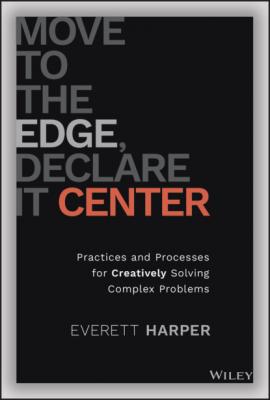Move to the Edge, Declare it Center. Everett Harper
Чтение книги онлайн.
Читать онлайн книгу Move to the Edge, Declare it Center - Everett Harper страница 12
 target="_blank" rel="nofollow" href="#ulink_7dcaa821-a398-504b-b3d9-4301094ae7d0">8. The second is that we do work in teams, not individually, but the cultural remnants of “solo” work still influence the way we think about solving problems. Alan Cooper, Twitter, November 8, 2018, https://twitter.com/mralancooper/status/1060553914209071106.
target="_blank" rel="nofollow" href="#ulink_7dcaa821-a398-504b-b3d9-4301094ae7d0">8. The second is that we do work in teams, not individually, but the cultural remnants of “solo” work still influence the way we think about solving problems. Alan Cooper, Twitter, November 8, 2018, https://twitter.com/mralancooper/status/1060553914209071106.9 9. The Agile Manifesto, https://agilemanifesto.org/.
10 10. A phrase we use at Truss is: “Be Agile, not Do Agile.” There is a limit to the codification of Agile, because when Agile becomes just another gate for certification, companies lose sight of the purpose. Don't do this.
11 11. Eric Ries, The Lean Startup: How Today's Entrepreneurs Use Continuous Innovation to Create Radically Successful Businesses (New York: Crown Business, 2011); Steve Blank, The Four Steps to the Epiphany: Successful Strategies for Products that Win, 5th ed. (Hoboken, NJ: John Wiley & Sons, 2020).
12 12. General Stanley McChrystal, Tantum Collins, David Silverman, and Chris Fussell, Team of Teams: New Rules of Engagement for a Complex World (New York: Portfolio/Penguin, 2015).
13 13. BIPOC refers to Black, Indigenous and People of Color. It is an imperfect term to address Black, Indigenous, Latino/a/x, Indian, and Pacific Islander bodies of culture. There are well‐reasoned arguments against BIPOC, notably those that the desire to create an inclusive term also erases the specific cultural heritage between and within each group.
14 14. “Underrepresented minorities” is used here as a reference to US government designations used to make policy, such as the SBA 8(a) designation. For a software company like Truss, this would include women and Black founders/owners, but in other contexts it would include BIPOC owners as well. While the term may be accurate, it's another imperfect term that emphasizes “otherness” and erases specific context.
15 15. K. Y. Williams and C. A. O'Reilly III. “Demography and Diversity in Organizations: A Review of 40 Years of Research.” Research in Organizational Behavior 20 (1998): 77–140.
16 16. Katherine W. Phillips, Katie A. Liljenquist, Margaret A. Neale, “Is the Pain Worth the Gain? The Advantages and Liabilities of Agreeing with Socially Distinct Newcomers,” Personality and Social Psychological Bulletin (2008).
17 17. Katia Savachuk, “Do Investors Really Care About Gender Diversity?” Stanford Business, September 17, 2019. Article cites a study by David P. Daniels, Jennifer E. Dannals,Thomas Z. Lys and Margaret A. Neale.
18 18. Project Include: https://projectinclude.org/.
19 19. Daniel Kahneman, Thinking, Fast and Slow (New York: Farrar, Straus, & Giroux, 2011), p. 20.
20 20. This is a good meditation practice! However, it's a challenge to do one great breath, much less 30 minutes of attentive breathing.
21 21. There is a great list in Wikipedia, https://en.wikipedia.org/wiki/List_of_cognitive_biases, but I encourage people to read Thinking, Fast and Slow to explore the details of how and why these biases exist.
22 22. When commentators talk about intelligence: 62 percent of praise was aimed at players with lighter skin tone, 63.33 percent of criticism was aimed at players with darker skin tone. When commentators talk about work ethic, 60.40 percent of praise is aimed at players with lighter skin tone. See Danny McLoughlin, Racial bias in football commentary (Study): The pace and power effect, RunRepeat (August 6, 2021).
23 23. Jim Collins and Morten T. Hansen, Great by Choice: Uncertainty, Chaos, and Luck – Why Some Thrive Despite Them All (New York: Harper Business, 2011).
24 24. “Stats and Events,” CAL Fire, https://www.fire.ca.gov/stats-events/ and “California Wildfires History and Statistics,” Frontline Wildfire Defense, https://www.frontlinewildfire.com/california-wildfires-history-statistics/.
25 25. Walter B. Cannon, The Wisdom of the Body (New York: W.W. Norton & Company, 1932).
26 26. Shelley E. Taylor, Laura Cousino Klein, Brian P. Lewis, et al., “Biobehavioral Responses to Stress in Females: Tend‐and‐Befriend, Not Fight‐or‐Flight,” Psychological Review 107 (3) (2000): 411–429.
27 27. These patterns may not be evenly distributed. As we saw earlier, Shelley Taylor's research suggests women are more likely to “tend and friend.” I would not be surprised if there was a dimension that tested differences based on race, but I'm unaware of research that tested this yet.
28 28. Everett Harper, “Company Talk about Police Shootings, as Target and CEO,” Forbes, May 27, 2020.
29 29. Center for Advanced Study in Behavioral Sciences, CASBS Summit: The Future of Agency: Transforming the University and City‐State, Stanford University. November 30, 2015, https://youtu.be/VJzr85nfxgE CASBS Presentation.
Part 1 WHAT IS MOVE TO THE EDGE, DECLARE IT CENTER?
Making decisions under complexity and uncertainty requires sustained effort. The framework is composed of the methods of Move to the Edge and processes of Declare It Center. This combination enables others to participate, iterate scale, and sustain throughout the team or organization.
The methods of Move to the Edge and the processes of Declare It Center are both composed of a series of practices, Exterior and Interior. The Exterior Practices are visible, consisting of documents, playbooks, and processes. The Interior Practices are emotional, consisting of habits, inner work, and behaviors. Both are crucial. Exterior Practices alone can create the illusion of omniscience, ill‐prepared for the impact of human feelings. Interior Practices alone don't enable others to follow, share, and improve one's own work. Both are needed for organizations to move through complex, uncertain situations, and to then center on systems to sustain, scale, and share the work.